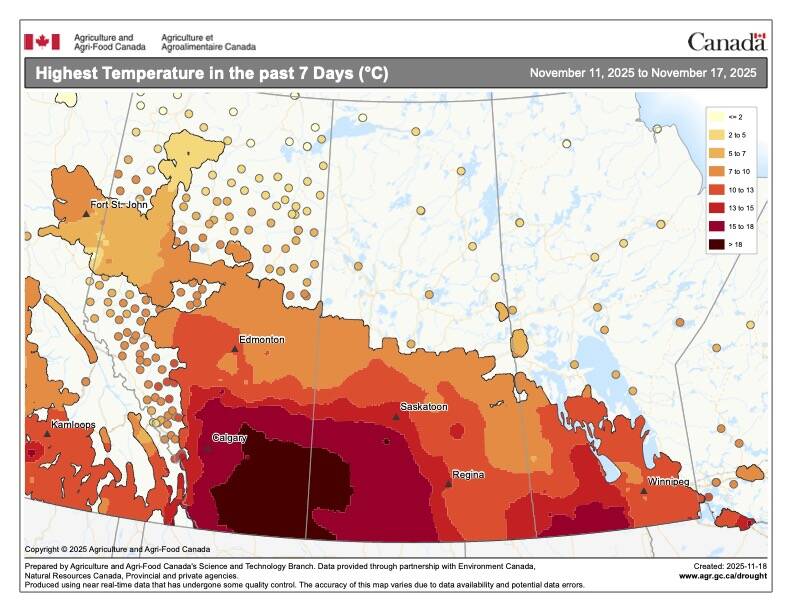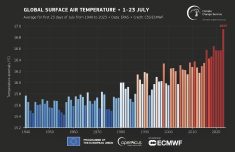It’s time to talk about record-breaking temperatures. Not daily records, not records for a city or a country, but global temperature records.
You may have read an article or two about how September shattered the global record for warmest month. August was also the warmest on record, globally speaking. It looks like 2023 will be the hottest year on record for the planet.
Let’s dig a little deeper.
Read Also

Is a weather station right for your farm?
Weather stations could make a great Christmas gift for the farmer in your life.
This data and statistics used here are provided by Copernicus Earth Observation Programme, and in particular, the Copernicus Climate Change Service (C3S) of the European Union. It is implemented by the European Centre for Medium-Range Weather Forecasts on behalf of the European Commission.
The ECMWF is an independent intergovernmental organization. You may recognize it as a provider of medium to long-range weather forecasts that I use regularly.
Globally, September had an average surface air temperature of 16.38 C, which was 0.93 C above the 1991-2020 average for September and 0.5 C above the temperature of the previous warmest September back in 2020.
For those who follow temperature records, breaking any record by 0.5 C is huge when it is a city or country record. When it is a global record, it is almost unheard of. Usually, these records are broken by a few hundredths to maybe one tenth of a degree.
According to C3S, September’s global temperature was the most unusually warm month of any year in its dataset, which goes back to 1940. The month was around 1.75 C warmer than the September average for the preindustrial reference period of 1850-1900.
August was also the warmest month on record globally, smashing the record by 1.25 C above the 20th century average. All major reporting agencies (NOAA, NASA, Japan Meteorological Agency and Copernicus) reported similar global temperatures in August.
The global temperature for January-September 2023 was 0.52 C higher than the 1991-2020 average, and 0.05 C higher than the equivalent period in the warmest calendar year, which was 2016.
Looking at the preindustrial average, so far January to September 2023 is 1.40 C higher globally. At the end of August, there was a 93 per cent chance that 2023 will be the warmest year on record and odds have definitely gone up since then.
Along with record warm global surface air temperatures, the planet also saw record warm global ocean temperatures.
On July 31, Copernicus reported that the average global ocean temperature had broken the previous warmest record, which was then matched or beaten every day in August.
With all that oceanic heat and with El Nino becoming a strong event that may last through winter and into spring 2024, I would not be surprised if more monthly global temperature records fall, making 2023 the warmest year on record.
Literally putting the icing on the global temperature record-breaking cake are the Arctic and Antarctic Sea ice conditions.
Antarctica is just coming off the Southern Hemisphere winter and the peak growth period for sea ice. After ending the summer with record low minimum extent in February, it was clear by May that Antarctic sea ice was tracking far below previous daily lows in the satellite record.
By the middle of July, which is the middle of its winter, ice extent stood at more than 2.60 million square kilometres below the 1981 to 2010 average. By the end of the Southern Hemisphere winter in early September, the Antarctic ice extent reached an annual maximum of 16.96 million sq. km, which was 1.03 million sq. km below the previous record low set in 1986.
That area is about the size of Ontario.
Once again, we usually do not see records broken by these large amounts. There is some discussion among scientists that the ice conditions around Antarctica may be heading into a new regime of increasing decline due to warming oceans.
At the northern pole of our planet, the summer minimum ice extent was reached Sept. 19, with an annual minimum of 4.93 million sq. km. This was the sixth lowest on record, even after a lacklustre melt season.
There about 3.45 million sq. km of ice have been lost since accurate record keeping began in 1979. That is the equivalent area of all four western provinces plus the Yukon.
Tie all that extra open water with what we have learned about albedo, the absorption of heat and subsequent distribution of that heat, and you start to understand how this one piece of the global puzzle can impact the whole planet.
It can be depressing, but it is becoming our new reality and we will have to adapt.















